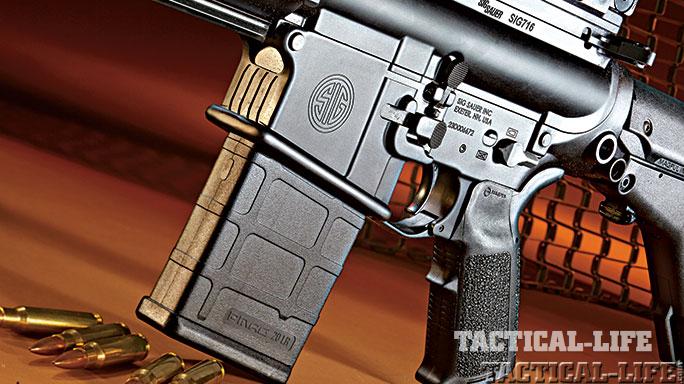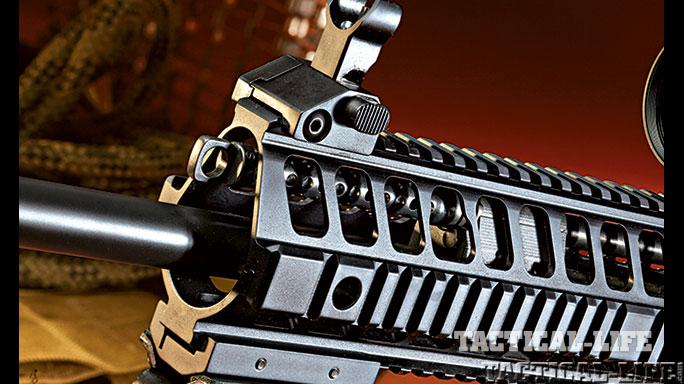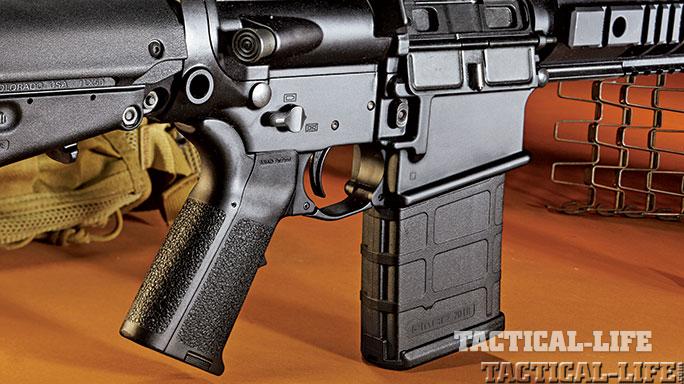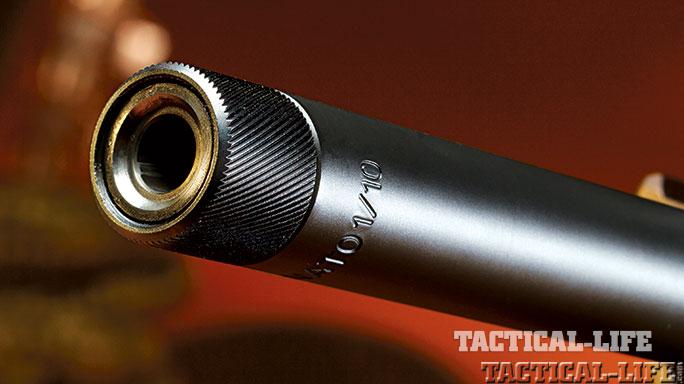There is a common misperception that piston-driven ARs just aren’t very accurate. If you ask many people familiar with ARs, they’ll tell you that a direct-impingement gun can be made to be very accurate, but a piston-operated gun can’t. We’ll, that may be true in some cases, but Sig Sauer has figured out a way to make a piston gun chambered in 7.62mm NATO as accurate as many precision bolt-action rifles.
- RELATED: Sig Sauer Introduces the Cutting-Edge MCX For 2015
- RELATED: Sig Sauer Reveals Electro-Optics For 2015
What’s going on here? Sig Sauer is a bit tight lipped about what exactly the company has done to make the gun as accurate as it is, but I know it has been working on the precision version of the SIG716 for at least three years. I was made aware of the gun when I visited the Sig Sauer factory at the time the 5.56mm piston AR, the SIG516, was introduced (an equally impressive firearm, by the way). Although work was progressing well on the 7.62mm SIG716 Patrol, it had not been completed at that point and the DMR was still in the developmental stages.
Gun Details
Advertisement — Continue Reading Below
The SIG716 DMR, or Designated Marksman Rifle, is a good-looking AR with some interesting design characteristics. For one thing, there is no included muzzle device. Instead, the muzzle has 5/8×24 threads and is supplied with a protective screw-on collar. The idea behind it is to make the gun ready for whatever muzzle device the owner wants to install—and there are a lot of options, from flash suppressors to muzzle brakes to sound suppressors. (Incidentally, Sig is now offering its own line of SIG-SD sound suppressors.) For testing, though, I ran the gun with only the protective collar installed.
“Sig Sauer has figured out a way to make a piston gun chambered in 7.62mm NATO as accurate as many precision bolt-action rifles.”
The match-grade barrel is made of chrome-moly-vanadium steel, a great choice for accuracy. It’s cold-hammer forged by Sig Sauer in New Hampshire and is 18 inches long with a 1-in-10-inch twist rate. It’s a heavy barrel and is finished with black oxide. Some may complain about the barrel not being longer than 18 inches, but there is a case to be made for the shorter barrel. First, barrel length doesn’t have anything to do with accuracy. It can give you a longer sight radius, which helps if the front sight is mounted at the end of the barrel, but that’s not an issue with this gun. And for those who might complain about a loss in velocity, realize that only about 25 to 50 feet per second (fps) is lost for each inch of barrel length reduction. So, at the onset, this gun gives up only about 100 fps at the muzzle compared to a 20-inch barreled gun. If the muzzle speed drops from 2,650 fps to 2,550 fps, a 168-grain Sierra MatchKing BTHP projectile loses a small amount of velocity at 800 yards.
Advertisement — Continue Reading Below
The SIG716 DMR has a top Picatinny rail running from the front of the handguard, which is about 13 inches long, to the rear of the upper receiver. Attached to it are front and rear flip-up sights that are adjustable for windage and elevation. And the rail is integral to the handguard, so there is no worry that the front and rear sight will not be on the same plane. The handguard also has rails at the 3, 6 and 9 o’clock positions along with quick-detach (QD) sling swivel sockets on the left and right sides at the front and rear. There are also QD sling swivel sockets at the rear of the lower receiver.
The upper and lower receivers are made of 7075-T6 aluminum that have been hardcoat anodized black. The upper receiver has the usual bolt forward assist and an ejection port cover. The charging handle is large to facilitate fast cycling. To keep the interface between the upper and lower receivers nice and snug to enhance accuracy, Sig Sauer uses a spring-loaded plunger at the rear of the lower receiver that imparts pressure on the upper when the gun is assembled.
“The factory test target is … shipped with the gun to show the rifle’s accuracy potential. The group for this gun measured 0.39 inches for five rounds.”
Advertisement — Continue Reading Below
The lower receiver has an ambidextrous safety selector—although my test gun, being an early sample, was not equipped with one—and an ambidextrous magazine release. A very large fence surrounds the magazine release to prevent inadvertent activations, and the magazine well is nicely beveled to aid in fast magazine insertions. Two Magpul 20-round PMAG magazines were supplied, and during testing they worked perfectly.
The rifle also comes with a Magpul MIAD pistol grip with three interchangeable backstraps and two different frontstraps that allow the shooter to customize it to suit their hand size and preference for finger grooves. It is also textured for slip resistance and has a storage compartment accessed by a bottom cover. The grip angle is not as pronounced as the A2 grip, making it more comfortable for most users.
A good trigger can do a lot to help accuracy, so Sig Sauer installs a Geissele SSA match unit. It’s a two-stage trigger with a smooth take-up, almost imperceptible creep and no discernible overtravel. When I measured the trigger on my test gun before firing, it broke at about 6.5 pounds. After firing about 50 rounds, the break weight dropped to just over 6 pounds. It’s a nice trigger. Sig also installed a Magpul triggerguard that provides a little extra room for a gloved finger.
Advertisement — Continue Reading Below
Sig also chose to equip my rifle with a Magpul UBR (Utility/Battle Rifle) buttstock. It has a fixed comb for a comfortable cheekweld, but can also be adjusted quickly to one of six length-of-pull positions. Though my test rifle came with a UBR, current SIG716 DMRs come with Magpul’s PRS stock, which is adjustable for length of pull and cheek height.
Sig Sauer went a step further with the buttstock and replaced the standard UBR rubber buttpad with an enhanced rubber buttpad that absorbs a bit more recoil and provides a little better gripping surface to keep it planted in the shoulder pocket under recoil. Sig Sauer has also added an optional storage compartment that is accessed by a cover on the side. Additionally, the storage compartment can be moved to the other side of the stock if desired.
The buttstock also has QD sling swivel sockets at the front and rear that can be switched easily from one side to the other. Those sockets, combined with the six on the receiver and handguard, provide a wide variety of sling attachment options for the single/two-point sling that is provided with the gun. The sling isn’t a flimsy, narrow one either. It’s 1.25 inches wide, has plenty of length adjustment and uses quality QD hardware and buckles.
Advertisement — Continue Reading Below
The all-important bolt carrier is made of AISI 8620 steel, and the bolt is manufactured from Carpenter 158 steel. The bolt also has a magnesium-phosphate finish. Dual ejectors kick fired brass clear of the receiver with authority, and the bolt carrier has an integral boss against which the piston rod impinges to send the bolt carrier group to the rear during the cycling process. The boss is not attached with screws, as these can sometimes loosen under constant impact.
The rear of the bolt carrier is wider than the body so that it fits more snuggly inside the receiver extension or buffer tube. This reduces carrier tilt, a characteristic of piston-driven ARs that is caused by the piston rod pushing the bolt carrier boss, which is not on the centerline of the bolt carrier. This can cause the bolt carrier to tilt downward at the rear, creating excessive wear, which the flared back end on the Sig prevents.
Sig Sauer’s piston system consists of a piston that rides inside a gas plug or valve that fits inside the gas block, which is located about 8 inches forward of the chamber. Sig Sauer experimented with the gas port’s placement and found that locating the port where it is helps enhance the rifle’s accuracy.
Advertisement — Continue Reading Below
The gas valve can be rotated to one of four positions. The standard position is meant for operation under normal conditions. Rotating the valve one click left opens the gas port a bit for use when the gun is dirty, performance is sluggish and the operator cannot stop to clean the gun. Rotating it one click to the right reduces gas flow for use with a suppressor. Turning it two clicks to the right cuts off the gas, which requires the gun to be cycled by hand. This can be useful when using a suppressor or when a military operator does not want to leave behind fired brass. To move the valve to the suppressor or cut-off position requires that a plunger at the front of the gas block be depressed. Speaking of duty usage, the piston-driven SIG716 DMR has already been adopted by some law enforcement and foreign military units.
Range Time
To test the rifle’s accuracy, I mounted a Steiner Military 5-25x56mm scope using a LaRue Tactical QD mount. I fired a variety of loads from a bench at 100 yards using the supplied Harris bipod. While not every group measured less than an inch, I did manage to get some as small as about half an inch. This proves that the gun is very accurate and rivals many bolt-action precision rifles.
Advertisement — Continue Reading Below
There is no question that the rifle is accurate. In fact, Sig Sauer test-fires SIG716 DMRs in a 100-yard test tunnel using a fixture to eliminate the shooter’s ability from the equation. The factory test target is then shipped with the gun to show the rifle’s accuracy potential. The group for this gun measured 0.39 inches for five rounds.
For more information, visit sigsauer.com or call 603-610-3000.
































